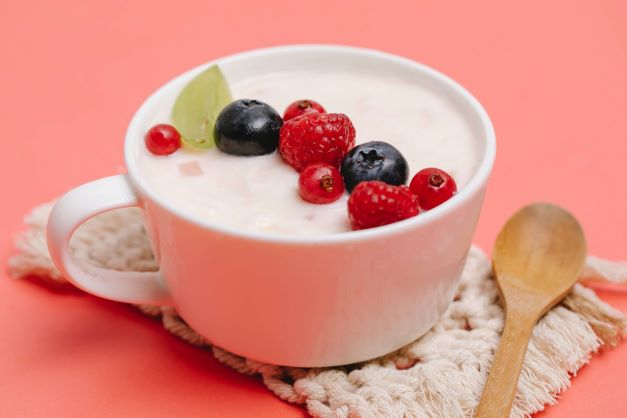Greek yogurt, a beloved dairy product renowned for its rich and creamy texture, has captured the hearts and palates of health-conscious individuals and food enthusiasts alike.
But what sets Greek yogurt apart from its regular counterpart? The answer lies not only in its texture but also in its unique taste profile.
In this comprehensive exploration of Greek yogurt, we will delve deep into what gives it its distinctive taste, its varying flavors and textures, and why it has become a staple in modern culinary culture.

Table of Contents
What Does Greek Yogurt Taste Like?
The taste of Greek yogurt can vary depending on the brand and flavor, but it is generally described as being tangier and less sweet than regular yogurt.
The tanginess is due to the higher lactic acid content, which is produced by the bacteria during the fermentation process. Greek yogurt can also have a slightly salty taste, depending on the brand.
Some people find the tangy taste of Greek yogurt to be refreshing and pleasant, while others may find it to be too sour.
If you are new to Greek yogurt, you may want to start with a flavored variety, such as vanilla or honey, to get used to the taste. You can also add sweetness to plain Greek yogurt by adding honey, fruit, or syrup.
Read: Why Does Greek Yogurt Taste So Bad? – (Explained).
Embracing Tanginess
The tangy essence of Greek yogurt is a result of the prolonged fermentation period. This allows the live bacterial cultures to break down lactose into lactic acid to a greater extent compared to regular yogurt.
The outcome is a yogurt that carries a pronounced tang, which some may find invigorating and refreshing. It’s a flavor that awakens the palate and adds depth to a variety of culinary creations.
A Spectrum of Flavors
While plain Greek yogurt stands as a testament to simplicity and versatility, the market offers an array of flavored options.
From classic vanilla to the more exotic blueberry-lavender, these variations cater to diverse palates. Flavored Greek yogurt can be a gateway for those new to its tanginess, offering a sweeter and more approachable introduction.
Read: How Long is Greek Yogurt Good for After Opening?
Balancing the Tang
For those who may find the tangy profile of Greek yogurt a tad intense, there are numerous ways to find harmony:
- Honey: The floral notes of honey complement the tanginess beautifully, creating a delightful sweet-and-tangy combination.
- Fruit: Whether fresh or dried, fruits like berries or bananas provide a natural sweetness that pairs harmoniously with Greek yogurt.
- Maple Syrup: A drizzle of pure maple syrup introduces a rich, caramelized sweetness, balancing out the yogurt’s tangy undertones.
- Agave Nectar: Offering a milder sweetness compared to honey, agave nectar is another excellent option for those seeking a touch of sweetness.
The interplay of tanginess and sweetness in Greek yogurt opens up a world of possibilities, making it a versatile ingredient in both sweet and savory dishes.
It’s a taste sensation that invites experimentation and culinary creativity.

The Tangy Allure of Greek Yogurt
Greek yogurt is renowned for its tangy flavor, a characteristic that distinguishes it from traditional yogurt.
This tanginess is a result of the higher lactic acid content found in Greek yogurt, which is a direct consequence of the fermentation process it undergoes.
During fermentation, live bacterial cultures, primarily Lactobacillus bulgaricus and Streptococcus thermophilus, break down lactose (milk sugar) into lactic acid.
The longer fermentation period of Greek yogurt allows for a more significant production of lactic acid compared to regular yogurt. This higher acid content imparts a delightful tangy and slightly sour taste to Greek yogurt.
The tanginess can vary between different brands and even between plain and flavored Greek yogurt varieties. Some people find the tanginess of Greek yogurt to be refreshing and invigorating, while others may perceive it as too sour.
The perception of this tangy flavor can be influenced by individual taste preferences and familiarity with yogurt types.

Variety in Flavors
While plain Greek yogurt stands as a versatile canvas, the market offers a diverse array of flavored options, catering to a wide range of tastes and preferences.
Classic Flavors:
- Vanilla: A timeless favorite, vanilla-infused Greek yogurt brings a delicate sweetness that complements the yogurt’s tanginess. Its versatility makes it an excellent base for both sweet and savory creations.
- Honey: The natural sweetness of honey adds a layer of depth to Greek yogurt. Its floral notes harmonize with the yogurt’s tangy profile, creating a balanced and flavorful combination.
- Fruit Varieties: From luscious berries to tropical delights like mango and pineapple, fruit-flavored Greek yogurt introduces a burst of natural sweetness and a medley of vibrant flavors.
Exotic Combinations:
- Blueberry-Lavender: This intriguing fusion marries the earthy, floral notes of lavender with the sweet tartness of blueberries. The result is a sophisticated flavor profile that elevates the yogurt experience.
- Fig-Honey: A marriage of sweet figs and honey creates a rich, indulgent flavor. This combination strikes a perfect balance between the natural sweetness of figs and the golden allure of honey.
Nut and Spice Infusions:
- Almond Butter and Cinnamon: The nutty richness of almond butter, combined with the warm, aromatic notes of cinnamon, transforms Greek yogurt into a comforting and satisfying treat.
- Coconut and Cardamom: The tropical sweetness of coconut meets the exotic allure of cardamom in this unique flavor pairing. It brings a touch of the exotic to your yogurt experience.
Savory Flavors:
- Herb and Garlic: Greek yogurt infused with herbs like dill, parsley, and a hint of garlic creates a savory delight. It’s an excellent base for dips, spreads, and dressings.
- Cucumber and Mint: The refreshing combination of cool cucumber and vibrant mint creates a savory yogurt option that’s perfect for dips or as a cooling side dish.
These varied flavor options not only cater to individual taste preferences but also open up a world of culinary possibilities.
Whether you lean towards the classic or crave the adventurous, there’s a Greek yogurt flavor to suit every palate.

Adding Sweetness
For those who find the tangy profile of plain Greek yogurt a bit robust, there are several delightful ways to introduce sweetness, enhancing the overall flavor experience.
1. Honey:
Honey emerges as a natural and harmonious partner to Greek yogurt. Its golden, viscous texture and floral notes complement the yogurt’s tanginess beautifully.
Drizzling a spoonful of honey over your Greek yogurt not only provides a sweet contrast but also adds a layer of depth to the overall taste.
It’s a timeless combination that has stood the test of time, offering a perfect blend of sweet and tangy.
2. Fruit:
Fresh or dried, fruits offer a burst of natural sweetness that pairs exceptionally well with Greek yogurt.
Whether it’s the vibrant sweetness of berries, the creamy richness of bananas, or the chewy, concentrated sweetness of raisins, fruits introduce a medley of flavors and textures to the yogurt.
The combination of creamy yogurt and juicy fruits creates a delightful contrast that elevates the taste experience.
3. Maple Syrup:
Pure maple syrup brings a unique sweetness to Greek yogurt. Its rich, caramelized flavor adds a distinctive depth that complements the yogurt’s tangy undertones.
A drizzle of maple syrup not only enhances the overall taste but also introduces a touch of indulgence to your yogurt creation.
4. Agave Nectar:
For those seeking a milder sweetness, agave nectar is an excellent option. Its light, neutral flavor seamlessly blends with Greek yogurt, offering a subtle sweetness without overpowering the tangy profile.
It’s a versatile sweetener that allows the yogurt’s natural flavors to shine through.
These sweetening options not only balance the tanginess of Greek yogurt but also open up a world of creative possibilities.
Whether you prefer the rich, earthy notes of honey, the bright burst of fruits, or the subtle sweetness of maple syrup or agave nectar, each option adds a unique dimension to your yogurt experience.
Experimenting with different sweeteners allows you to tailor your Greek yogurt to your exact taste preferences, making it a personalized culinary delight.
The Creamy, Luxurious Texture
Beyond its distinctive taste, Greek yogurt is celebrated for its sumptuously creamy texture. This thickness sets it apart from regular yogurt and opens up a world of culinary possibilities.
The Texture Transformation
The secret behind Greek yogurt’s creamy texture lies in the meticulous straining process it undergoes. While regular yogurt is typically enjoyed as is, Greek yogurt takes an extra step that elevates its consistency to a whole new level.
The Straining Process
After the initial fermentation period, Greek yogurt is subjected to a crucial step: straining. This involves passing the yogurt through a fine mesh or cheesecloth. What this achieves is the removal of excess whey and lactose.
Whey and lactose are both thin liquids. By eliminating them, what’s left behind is a yogurt that is notably denser, richer, and less watery. The resulting texture is a stark departure from traditional yogurts, which tend to be creamier and more fluid.
The Result: Creaminess Redefined
The outcome of this straining process is nothing short of a textural revelation. Greek yogurt becomes luxuriously thick and creamy, setting it apart not only from regular yogurt but also from a variety of dairy products.
Its consistency becomes akin to whipped cream or custard, making it an exceptional ingredient in a multitude of culinary applications.
A Versatile Substitute
The transformed texture of Greek yogurt grants it a versatility that extends far beyond being a standalone dairy product. It becomes an ideal substitute for a range of ingredients in cooking and baking.
In Recipes:
Greek yogurt seamlessly takes the place of sour cream or cream cheese in a diverse array of recipes. From dips and dressings to sauces and desserts, its creamy richness elevates the overall texture and flavor of the dish.
In baking, it imparts a moist, decadent quality to cakes, muffins, and other treats.
As a Standalone Treat:
Enjoyed on its own, Greek yogurt becomes a sumptuous delight. Its velvety mouthfeel and creaminess satisfy cravings for a luscious treat, all while providing a nutritional punch.
Culinary Innovation:
Greek yogurt’s texture can be utilized in various culinary applications. It can be swirled into soups for a velvety finish, folded into mashed potatoes for extra richness, or blended into smoothies for a silky smooth consistency.
In essence, the texture transformation that Greek yogurt undergoes is a testament to the artistry of dairy production. It results in a product that not only excels in taste but also redefines what we expect from a dairy staple.
Nutritional Benefits of Greek Yogurt
Greek yogurt is not only a culinary delight, but it also boasts an impressive nutritional profile. It stands as a powerhouse of essential nutrients, making it a valuable addition to a balanced diet.
1. Protein Packed:
One of the standout features of Greek yogurt is its high protein content. It contains nearly double the amount of protein found in regular yogurt.
This makes it an excellent choice for individuals looking to increase their protein intake, whether for muscle building, weight management, or simply to maintain overall health.
2. Calcium-Rich:
Similar to regular yogurt, Greek yogurt is a good source of calcium. This essential mineral is crucial for maintaining strong bones and teeth, as well as supporting various bodily functions, including muscle contractions and nerve signaling.
3. Low in Calories and Fat:
Despite its creamy texture and rich taste, Greek yogurt is relatively low in calories and fat compared to its regular counterpart.
This makes it a smart choice for individuals who are mindful of their calorie and fat intake.
4. Probiotic Powerhouse:
Like all yogurt, Greek yogurt contains live bacterial cultures that are beneficial for gut health. These probiotics contribute to a balanced microbiome, which plays a crucial role in digestion, nutrient absorption, and overall immune function.
5. Essential Nutrients:
In addition to protein, calcium, and probiotics, Greek yogurt provides a host of other essential nutrients.
It is a source of vitamins such as B12, riboflavin, and phosphorus, which contribute to energy production, cell function, and bone health.
6. Satiety and Weight Management:
The combination of high protein and lower carbohydrates in Greek yogurt helps promote feelings of fullness and satiety.
This can be particularly beneficial for those seeking to manage their weight or maintain a healthy eating routine.
7. Versatility in Diets:
Greek yogurt fits well into various dietary patterns, including vegetarian, high-protein, and low-carb diets. Its nutrient density makes it a valuable addition to a range of eating plans.
Incorporating Greek yogurt into your diet not only elevates your culinary experience but also provides a wealth of essential nutrients.
Its high protein content, probiotic benefits, and low-calorie profile make it a versatile and nourishing addition to a balanced diet.
Versatile Uses of Greek Yogurt
Greek yogurt’s appeal goes far beyond its taste and texture; it’s an incredibly versatile ingredient that can enhance a wide range of dishes, both sweet and savory.
1. Parfaits:
Creating a parfait with Greek yogurt is a delightful way to enjoy its creamy texture and tangy flavor. Layer it with granola and fresh fruit for a nutritious and visually appealing breakfast or snack option.
2. Dips:
Greek yogurt serves as an excellent base for creating creamy and flavorful dips. Combine it with various herbs, spices, and ingredients like chopped cucumber, dill, and garlic for a healthy and refreshing dip that pairs perfectly with vegetables, pita bread, or even as a spread on sandwiches.
3. Smoothies:
Incorporating Greek yogurt into your morning smoothie enhances its creaminess and boosts its protein content. Blend it with your favorite fruits, vegetables, and a liquid of your choice for a quick and nutritious beverage.
4. Baking:
Greek yogurt can be a secret weapon in baking. Its moisture and acidity contribute to the texture and flavor of baked goods. Use it as a substitute for ingredients like sour cream or buttermilk in recipes for cakes, muffins, and pancakes to achieve moist and tender results.
5. Sauces:
Greek yogurt serves as an excellent base for creating creamy sauces. Whether for pasta, chicken, seafood, or even as a topping for baked potatoes, it adds richness and a tangy undertone that elevates the dish.
6. Marinades:
The thick consistency of Greek yogurt makes it an excellent medium for marinades. Its creaminess helps adhere flavors to proteins like chicken, lamb, or tofu, resulting in tender and flavorful dishes after cooking.
7. Dressings:
Greek yogurt forms the base of a variety of dressings, from classic ranch to zesty tzatziki. Its creamy texture pairs well with herbs, spices, and other flavorings, creating a versatile dressing that can elevate salads, wraps, or sandwiches.
8. Substituting for Dairy:
Greek yogurt can be a healthy substitute for dairy ingredients in recipes. Whether replacing sour cream or cream cheese in savory dishes, or adding creaminess to desserts, it offers a lighter and more nutritious alternative.
9. Frozen Treats:
Greek yogurt can be transformed into a delicious frozen dessert. Combine it with fruits, honey, and nuts, and freeze for a guilt-free alternative to ice cream.
Greek yogurt’s versatility extends to virtually every corner of the culinary world. Its creamy texture, tangy flavor, and nutritional benefits make it a valuable addition to a wide range of dishes, from breakfast to dinner and everything in between.
Related FAQs:
Is Greek yogurt sourer than regular yogurt?
Yes, Greek yogurt tends to have a tangier and less sweet taste compared to regular yogurt. This is due to its higher lactic acid content, which develops during the fermentation process.
Can I adjust the taste of Greek yogurt if I find it too tangy?
Absolutely! You can customize the taste of Greek yogurt to suit your preference. Adding sweeteners like honey, fruits, or syrups can help balance out the tanginess.
What are some popular flavors of Greek yogurt?
Greek yogurt comes in a wide range of flavors, including classic options like vanilla and honey. There are also more unique combinations like blueberry-lavender and fig-honey for those seeking adventurous tastes.
Does Greek yogurt have a salty taste?
While Greek yogurt can have a slightly salty taste, it’s not a dominant flavor. The level of saltiness can vary depending on the brand and specific product.
Can I use Greek yogurt as a substitute for sour cream in recipes?
Absolutely! Greek yogurt’s creamy texture and tangy flavor make it an excellent substitute for sour cream in a variety of recipes, from dips to baked goods.
How does the taste of homemade Greek yogurt compare to store-bought varieties?
Homemade Greek yogurt can have a fresher and more nuanced taste compared to store-bought options, which may have added preservatives or flavorings. The taste can also be influenced by the quality of the ingredients used.
Are there any savory dishes where Greek yogurt is commonly used?
Yes, Greek yogurt is a versatile ingredient in savory dishes. It’s often used in dips, sauces, and dressings, adding creaminess and a tangy element to dishes like tzatziki, creamy pasta sauces, and more.
Can I use Greek yogurt in baking?
Absolutely! Greek yogurt can be used as a substitute for dairy ingredients like sour cream or buttermilk in baking recipes. It contributes moisture and a slight tanginess to baked goods.
Is Greek yogurt a good option for those with lactose intolerance?
Greek yogurt is typically well-tolerated by individuals with lactose intolerance, as the straining process reduces lactose content. However, individual tolerance levels may vary, so it’s advisable to monitor how your body responds.
Conclusion
Greek yogurt is a delightful dairy product that combines a tangy taste with a creamy texture, making it a versatile and nutritious addition to a wide range of culinary creations.
Whether enjoyed plain with a drizzle of honey or incorporated into complex dishes, Greek yogurt offers a world of flavor possibilities to explore.
Its tanginess, creamy consistency, and nutritional benefits make it a favorite among health-conscious individuals and food enthusiasts alike.
Whether you are a seasoned Greek yogurt aficionado or new to its tangy allure, there is no denying that this dairy delight has earned its place in the modern culinary landscape.
So, embrace the tang and savor the creaminess—it’s time to elevate your yogurt experience with Greek yogurt.
